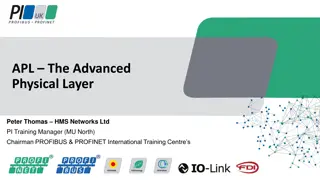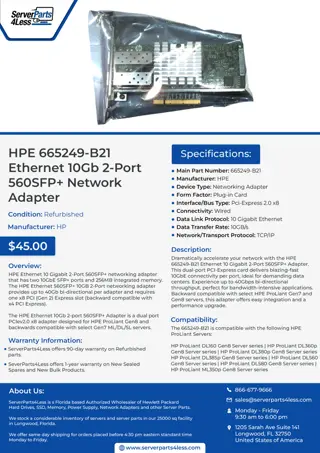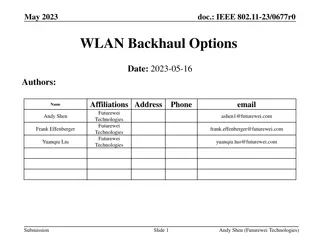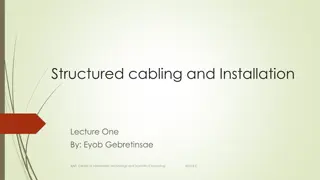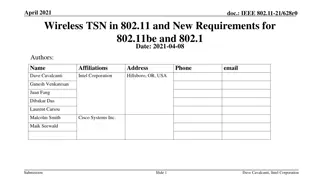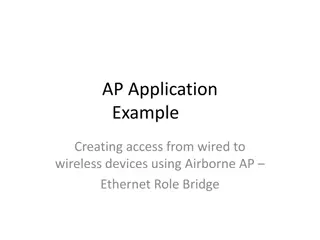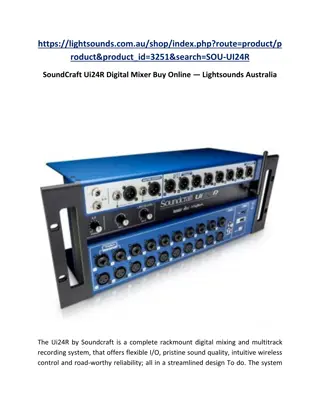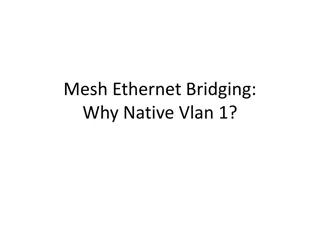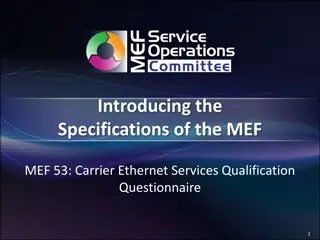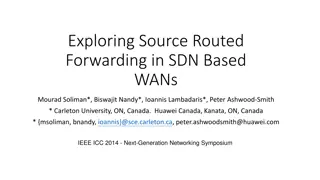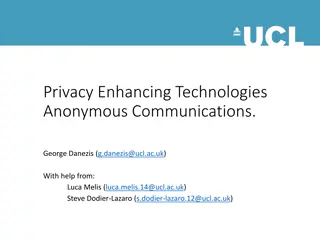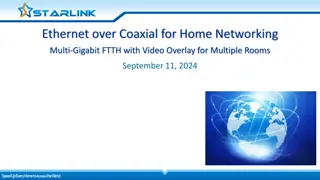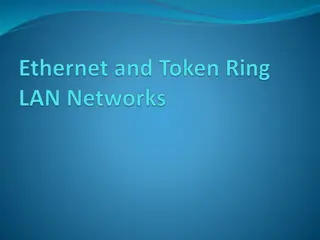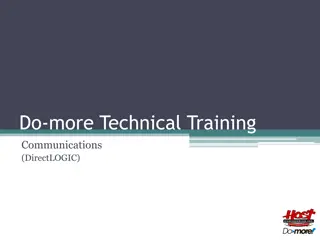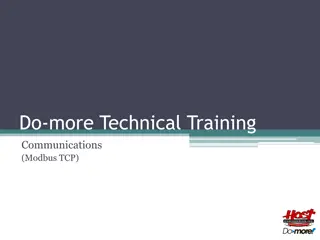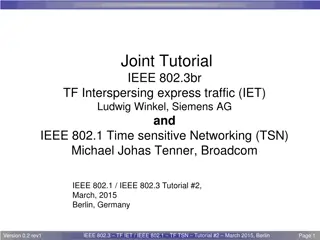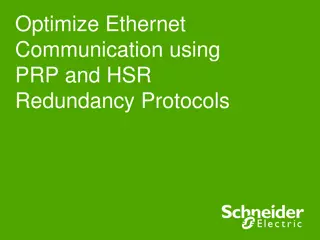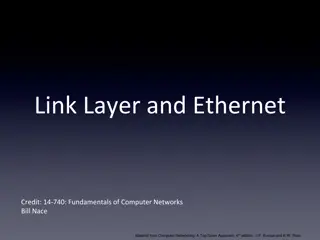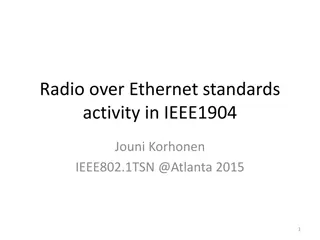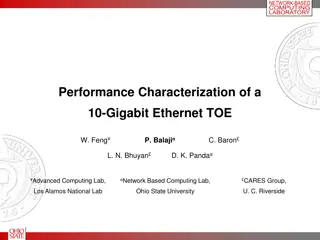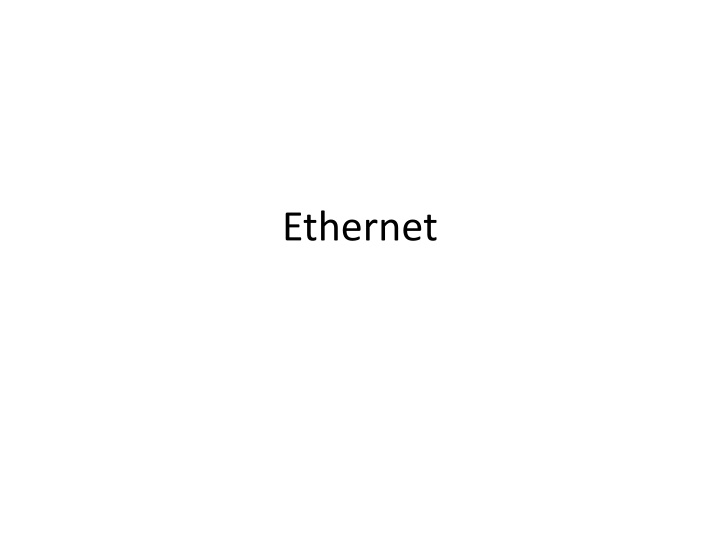
Evolution of Ethernet: Standards, Usage, and Milestones
Discover the evolution of Ethernet from its invention in 1973 to the latest advancements in 1000Mbps Ethernet. Learn about the standards, topologies, and usage of Ethernet technology, including its impact on networking and data centers.
Download Presentation

Please find below an Image/Link to download the presentation.
The content on the website is provided AS IS for your information and personal use only. It may not be sold, licensed, or shared on other websites without obtaining consent from the author. If you encounter any issues during the download, it is possible that the publisher has removed the file from their server.
You are allowed to download the files provided on this website for personal or commercial use, subject to the condition that they are used lawfully. All files are the property of their respective owners.
The content on the website is provided AS IS for your information and personal use only. It may not be sold, licensed, or shared on other websites without obtaining consent from the author.
E N D
Presentation Transcript
Ethernet standards milestones 1973: Ethernet Invented 1983: 10Mbps Ethernet 1985: 10Mbps Repeater 1990: 10BASE-T 1995: 100Mbps Ethernet 1998: 1000Mbps Ethernet 2002: 10Gbps Ethernet 2010: 40Gbps and 100Gbps Ethernet
Ethernet Usage Most widely used networking technology. Everything generic computer has one or more Ethernet port. Data center machines are mostly connected with Ethernet.
The original Ethernet Robert Metcalfe s design Multiple stations tap into a shared communication medium called the Ether.
The original Ethernet Robert Metcalfe s design Multiple station tapped into a shared medium call the Ether. Since the communication medium is shared, only one station can communicate: need a Medium Access Protocol (MAC), Carrier Sense Multiple Access (CSMA) with collision detection (CD), CSMA/CD. CSMA: sense the medium; if nobody is talking, talk Two stations can start talking at the same time due to signal propagation delay. CD: monitor the medium while talking, if as soon as a garbled message is heard, stop talking, exponential back-off.
Topologies: logically the same Bus topology Coax Cable (10Base2, 10Base5) around 1985 Repeater Star topology 10Base-T, Half-duplex Dominates in later for easy management
Standard IEEE std 802.3, CSMA/CD Packet size: 64Bytes to 1500 Bytes Why minimum and maximum sizes? Packet format: Speed: 10Mbps Network size < 2500m
100Mbps Ethernet (Fast Ethernet) Same protocol, same packet format/size, faster speed 100Mbps Other impact besides technology advances? Network size?
1000Mbps Ethernet Better cable quality Jumbo frame for large messages Retain CSMA/CD If do nothing in the minimum frame size, the network size can only be 250/10 = 25m!! Solution: Carrier extension to make minimum frame size to 4096 bits (512 bytes) to keep the size to 250m. Nobody uses the CSMA/CD mode at 1Gbps. All switched.
Switched Ethernet In 1992/1993, change the repeater to a switch Repeater: always broadcast Switch: only send to the targeted port Switched Ethernet is contention free. Today, wired Ethernet are mostly switched Ethernet. CSMA is still used in Wireless Ethernet, evolved to CSMA/CA Collision No collision Repeater Switch Collison free Full duplex 10/100Base-T
Switched Ethernet Topology management Not doing broadcast anymore, how do we make sure that all packets can reach their destinations? Fall-back mode If a switch does not know what to do with a packet (destination not in the forwarding table), do broadcast (send to all ports except the incoming port). Normal mode Backward learning algorithm If a switch sees a packet from A at port X, put (A, X) in the forwarding table. Now, it knows what to do with packet to A.
Switched Ethernet Fall-back mode, broadcast will cause problem in a topology with a loop. One packet with unknown destination will trigger a packet storm that would saturate all links in the loop. Solution: using a spanning tree algorithm to make a topology without any loop (single path from one switch to any other switch). Switched Ethernet only supports a tree topology. Switch Switch Switch
Switched Ethernet allows a topology with multiple speeds.
Ethernet and the upper level Internet hosts typically runs TCP/IP/Ethernet protocol stack. Ethernet is designed for the cost. Ethernet card is low-cost without much logic Need to use CPU to move data into and out of the buffers in the card. There is typically a parameter in the OS to set the minimum time interval to generate interrupts. Too much interrupt can consume the whole CPU, seen even in 1Gbps Ethernet. If uncontrolled, the card can generate more than 1000000 interrupts per second. Communication Latency is very large with the traditional Ethernet
Ethernet development trend Leave the MAC alone 10X performance at 3-4X the cost Keep Interoperability: plug and play
10 Gigabit Ethernet A lot of focuses on the physical medium big difference in 1Gbps and 10Gbps links. Fibers cabling only. MAC protocol: still an Ethernet 802.3 frame format 802.3 min/max frame size Full duplex operation only, no more CSMA/CD LAN and WAN -- Runs long distance
Ethernet enhancements for data centers Traffic differentiation: Priority groups End-to-end traffic differentiation, not longer pure best-effort Multiple queues for different priority groups. Lossless fabric: reliable transport Like traditional HPC networks (e.g. InfiniBand) Transient congestion: priority based flow control Persistent congestion: backward congestion notification Fat-tree topology: shortest-path bridging No longer spanning tree algorithms L2-multi-pathing
Shortest path bridging Incremental advance to MSTP Builds a spanning tree for each bridge Using the spanning tree rooted at the source switch for shortest path bridging. Data center bridging a more newer extension. Switch Switch Switch
Ethernet Hardware Acceleration Interrupt coalescing Improves throughput, but hurts latency Jumbo frames Segmentation offload engine (virtual MTU) CPU sends jumbo frames, adapter splits the frame into regular sized frame Server side optimization Good for server connecting to regular clients
Ethernet Hardware Acceleration TCP offload Engines Hardware Acceleration for the entire TCP/IP stack The network adapter supports the whole TCP/IP Internet Wide-Area RDMA protocol (iWARP) Support RDMA over Ethernet
40GB, 100GB Ethernet Standardized in 2012 Just buff up the speed. Features: Full duplex operation only Preserve 802.3 frame format Preserve 802.3 minimum and maximum frame size Maintain the bit error rate 10^{-12} use forward correction code. 40Gbps or 100Gbps over certain distances Mostly focus on the physical layer issues and technology to achieve the rate. Ethernet is becoming a link technology.

